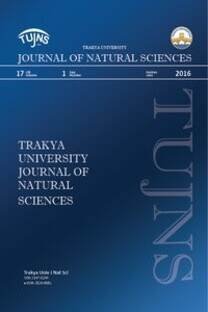SİKLOHEKZAN KARBOKSİLLİ ASİDİN SODYUM VE KOBALT TUZLARININ ELDESİ VE SODYUM TUZUNUN ANTİMİKROBİYAL AKTİVİTESİ
Son yıllarda geçiş metal naftenatlarının (karboksilatlarının) sentezi çok fazla uygulama alanına sahip olduğundan büyük öneme sahiptir. Bu tip anorganik sentezler yeni koordinasyon bileş iklerinin elde edilmesine ve incelenmesine neden olmuştur. Burada halkaya sahip karbon asitlerinin kompleks meydana getirmesini ve bunların basit karboksilatlardan farkını belirlemek için çalışmalar yapıldı. Naftenik asit (siklohekzan karboksilikas it) ile NaOH'in karşılıklı etkisiyle sodyum karboksilat elde edildi. Daha sonra yer değiştinne reaksiyonu ile kobalt naftenat sentezlendi. Kobalt karboksilatın optimal sentezi, iki basamaklı yer değiştirme reaksiyonu ile gerçekleşmiştir. Elde edilen asit ve naftenatların IR, NMR spektrumları ve kobalt naftenatın termegravimetrik analizi alınarak fiziksel, kimyasal özellikleri ve kristal yapısı incelenmiştir. Sodyum karboksilatın antimikrobiyal aktivitesi Gram-pozitif kok (Staphylococcus aureus), Gram-negatif basit (Escheric!ıia coli) ve maya mantarında (Candida albicans) araştırılmıştır.
Anahtar Kelimeler:
Antimikrobi yal Aktivite, Ekstraksiyon Metodu, Karboksil atlar, Naftenik Asitler.
THE SYNTHESIS OF CYCLOHEXANE CARBOXYLIC ACID, ITS COBALT AND SODIUM SALTS AND ANTIMICROBIAL ACTIVITY OF SODIUM SALT
In the recent years, the synıhesis of transition metals naphtenates beauce very imporıant because of large application possibilities. Those types of inorganic synthesis become a reason for discovery and the study of new coordination compounds. The experiments are designeel to make complex compounds of eyetic carbon acid and to study their differences from simple carboxylates. By using of naphtlıanic acid (cycloheksanccarboxylic acid) and sodium hydroxide, sodium naphthenate is produced. Then applying substation reaction, cobalt naphthenate is synthesized. The optimal yields for cobalt naphtlhenate is obtained by a two step reaction. The physical and chemical properties and structural characteristics for acid and naphthenate are obtained by applying IR, NMR and termogravimetric analysis. In this study antimicrobial activity of sodium naphthenate was also in vestigated on Gram-positive cocci (Staphylococcus aureus), Gram-negative bacilli (Escherichia coli) and yeast (Candida albicans).
Keywords:
Antimicrobial Activity, Extraction Methocls, Carboxylates, Naphtenic Acids,
- ISSN: 1305-6468
- Başlangıç: 2000
- Yayıncı: -
